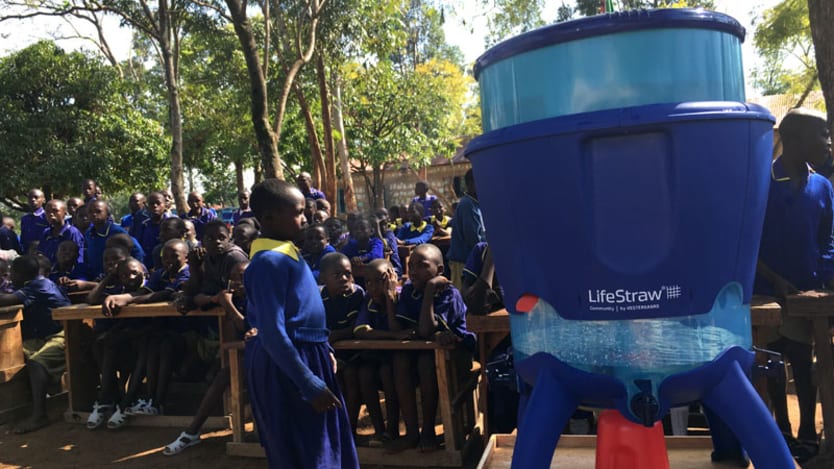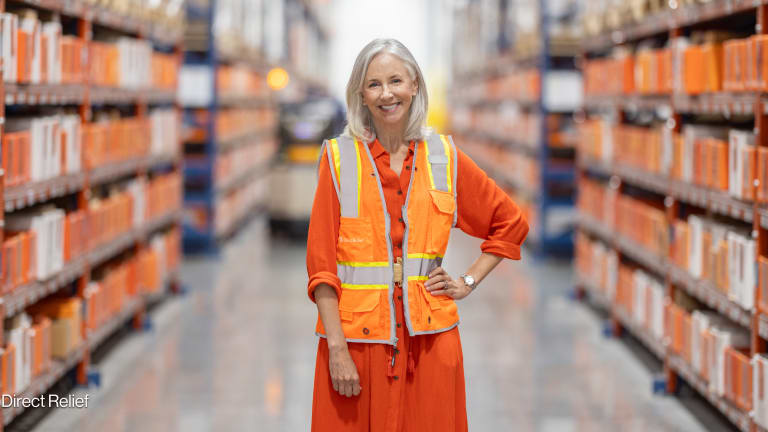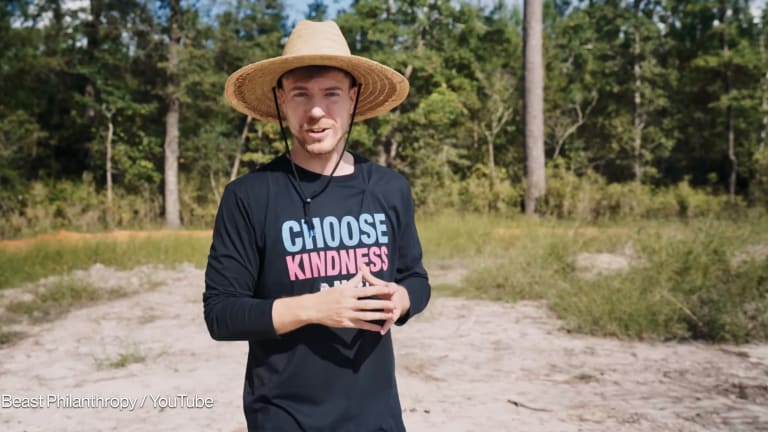
As the international community increasingly calls on business to help finance and implement the Sustainable Development Goals, the private sector has questions of its own — namely ‘What exactly is the market opportunity?’
Vestergaard is one example of a business that’s transformed itself into a vehicle to answer that question by tackling some of the world’s most pressing problems like malaria, safe drinking water and food security.
What they’ve proven over the years is that in the long term, doing good is in fact good business.
When Mikkel Vestergaard Frandsen first joined his family-owned textile company in Denmark, it primarily made uniforms for hotel clerks or supermarket employees. It was a lucrative business line — with revenues of $5 million a year — but Vestergaard Frandsen, brought in by his dad to work for the company, had bigger plans. Now, about 20 years later, the company, which focuses on providing solutions to key development challenges by drawing from its textile know-how, has increased its revenue 50 times.
They’ve done so by employing a strategy they call “humanitarian entrepreneurship,” a model and philosophy that strays from the norm for a typical corporation, Vestergaard Frandsen explained.
“I often meet some disbelief and I guess it’s people who at times need to see it first hand to understand that it is possible that doing good strengthens your company, that doing good attracts better talent and that doing good offers a mission-driven business and that doing good by and large is good for your bottom line,” he said.
He’s also a believer that the private sector has a big role to play in tackling development challenges, not least because they’re the ones creating a lot of the problems. And there will only be more opportunity as aid, and in particular United Nations agencies, shifts to focus only on the poorest countries and places in conflict.
“Who fills that vacuum? Is there a potential private sector alternative to the U.N.?” he said.
A personal mission
In late 2015, Vestergaard Frandsen could be found sitting with several local dignitaries under a tent in the central courtyard at the Chiyunzu Primary School in Kakamega, Kenya, facing a sea of more than 1,000 students.
He was greeted as an elder of the Luhyo tribe, an exceedingly rare honor for a white foreigner, at the ceremony launching the Vestergaard water brand LifeStraw’s annual distribution, where the company provides safe drinking water for a primary school student for each product sold in the U.S. or Europe. But it was when the presentation reverted to part education, part dance party that he seemed to come alive.
Those are the moments that seem to feed the adventure-seeking CEO’s reserves.
He’s 43, but will tell you he still feels 16 at heart. The kind of person who seems to do everything full force, he’ll run miles in the morning after staying up well into the night over several bottles of wine. He plans elaborate physical challenges, from riding parts of the Tour de France route, to hiring a personal trainer and chef for a bootcamp with friends in New York.
He’s a big personality, but is also introspective.
After finishing high school, Vestergaard Frandsen hitchhiked through North Africa, spending time in Egypt before eventually settling for a time in Nigeria at 19, buying trucks and engines in Europe and selling them in the West African country. A military coup eventually forced him home, where he found his way to the family business and to university.
He couldn’t imagine spending his life selling uniforms to people in Scandinavia, so he started up a branch of the company to sell blankets and tents for refugee camps to the likes of the British Red Cross and UNICEF. In less than two years, the unit had overtaken the rest of the family business.
But it wasn’t until later, when working on the company’s malaria bed net business, that things started to click for him. After experimenting with distribution models, Vestergaard helped innovate a new distribution method that combined health efforts like measles vaccination, vitamin A distribution and deworming with bed net distribution alongside megadonors like The Global Fund.
“I had my personal awakening at that point about just how much good you can do as a business,” he said. “My sense of responsibility shifted to something larger and with that the whole company’s sense of responsibility shifted. ... Since then I’ve been very involved with the role business ought to have.”
It’s partly because he grew up in Denmark that he came to expect that products related to basic human rights or health should be provided for free, which has framed his thinking that a traditional commercial model isn’t always the right approach — but that those with the “widest shoulders should carry the biggest load.”
After taking time off to think in 2015, as well as participating in forums like the LAUNCH council, an innovation platform founded by NASA, Nike, the U.S. Agency for International Development and the U.S. Department of State, Vestergaard is ready to think bigger than ever in reimagining, again, what his company might be capable of.

A company’s transformation
So how does a Danish textile company transform into a global company with more than 170 permanent employees, extensive research and development capabilities, and a social mission to tackle development challenges?
Not overnight.
Years after beginning the tents and blankets division — and after more than a few arguments with his father — Vestergaard Frandsen purchased his division of the company; the original business no longer exists, though his father continues to sit on the board. Meanwhile, increasing competition from Chinese and Indian manufacturers drove the team to start thinking about value-added textiles.
The first result was long-lasting insecticide-treated mosquito bed nets, followed by a nylon cloth capable of filtering guinea worm from water as well as insecticide-treated cloth tsetse fly traps.
Those early products sparked Vestergaard’s three focus areas, which are now split into individual companies under the parent company to work on public health, water and food security.
In recent years innovation has come in large part due to partnership, particularly when it comes to research and development. Thanks to current partners, many of them universities, the company can now tap a network of thousands of people for R&D projects for about the same cost as a much smaller in-house team.
Often one set of innovations inspires another. The early guinea worm filter, for example, led to the development of LifeStraw, a hollow fiber membrane filter that takes even the dirtiest water and makes it safe to drink. The original product, which has now morphed into its own growing brand popular among outdoor enthusiasts, was designed for humanitarian response.
The model of using developed world sales to finance related products or projects in developing countries seems to be on the rise — and while LifeStraw’s Follow the Liters program is not exactly a “buy one, give one” model, it might be mistaken for one. Vestergaard Frandsen is quick to respond to skeptics by saying that LifeStraw differentiates itseIf in several ways — one is that it addresses a basic human right and another is that it doesn’t dump products on the market, which is a chief criticism of buy one, give one efforts.
“The distinction is not so much in the how do you connect with the consumer, the distinction is what happens on the ground, how credible is your operation and do you actually make an impact or are you howling at the moon,” he said.
What it looks like in action
The test of LifeStraw’s impact is on the ground in Kakamega County in Western Kenya. In November 2015, teams of local community members and staff from across Vestergaard clad in royal blue T-shirts carried out the distribution of more than 2,500 filters, which will serve more than 200,000 students, as part of the LifeStraw’s Follow the Liters campaign.
The schools are chosen months in advance after surveys and meetings with local health and education officials help to determine where there is the most need — places like Laboot Primary School in the Mt. Elgon area in Western Kenya where the water source is an unprotected spring that emerges into a muddy puddle in a field littered with cow dung.
Then the multiple-tap LifeStraw community filters, which hold 50 liters of water and serve between 75 and 100 kids for a three- to five-year period, are ordered and begin their journey — by boat, truck, motorcycle and sometimes cow to their school.
There, local leaders, in animated speeches and smaller interactive sessions, teach about diarrheal diseases like typhoid and cholera, handwashing and how to boil or treat water at home so that it is safe to drink, using songs and sound effects of certain bodily functions to keep the students’ attention.
The development chops of the LifeStraw leadership team are apparent in the meticulous coordination of deliveries. Each school is assigned an ID number and barcode to avoid confusion with varied spellings and is recorded by its GPS coordinates, while each filter has its own number, both on a sticker and written with permanent marker on the unit itself.
While hard data from the regional health office was hard to come by, everyone — from a district health official, to the head nurse at a local clinic, to the head teachers at numerous schools — told Devex they have seen a drop in diarrheal diseases and improved attendance.
Head teacher Bilha N. Aura of Ebulafu Primary School, which got water filters last year through the program, said many fewer children are sick now, resulting in better learning. It’s become part of the routine, she said, and you can see children queuing to get water at break times. Most of these children are now drinking the majority of their daily water at school because some, if not most, don’t have access to clean water at home.
“For us to achieve health in totality has to be a multisectoral project,” said Aggrey Indeje, a subcounty public health officer in Kakamega, Kenya.
Indeje praised LifeStraw’s work and asked when it would expand to more schools. To that, Alison Hill, the managing director of Vestergaard’s water business, responded that while they will continue to expand the program this year, the government must take action as well and challenged him about what steps the Ministry of Health is taking to meet its commitments.
She later said that it’s about a give and take — Lifestraw does not necessarily expect to be the long term solution for the region, but “there is never a clear development funding path for water, especially at the household level,” Hill said.
LifeStraw’s approach is one way to bridge the gap, and this year it will look to launch similar programs in India, China and Mexico with sales in the latter countries supporting domestic programs and Asian sales supporting the program in India.
LifeStraw’s Follow the Liters program is part of the way Vestergaard is looking to move away from the traditional aid paradigm of transferred income funding development solutions.
“We know that we need at some point to graduate from aid so all the new businesses that we’re launching are independent from transferred income, but they’re still in the space of combining doing business and doing good,” Vestergaard Frandsen said.
That is part of what will guide the strategy review that Vestergaard recently launched to think through what the company might do in the next five years and how it will pivot from the Millennium Development Goals to align itself with the SDGs.
They’ll start with a blank slate and consider the biggest issues facing humankind. They’ll rank that list by priority, which will be their roadmap ahead, one that will likely continue to focus on public health, water and security but Vestergaard said may also extend to rural electrification, solar energy and the potential to reduce human trafficking.
EDITOR’S NOTE: In preparing this story, the reporter's travel in Kenya was financially and logistically supported by LifeStraw. Nonetheless, Devex retains full editorial independence and responsibility for this content.
Join Devex to network with peers, discover talent and forge new partnerships in international development — it’s free. Then sign up for the Devex Impact newsletter to receive cutting-edge news and analysis at the intersection of business and development.








